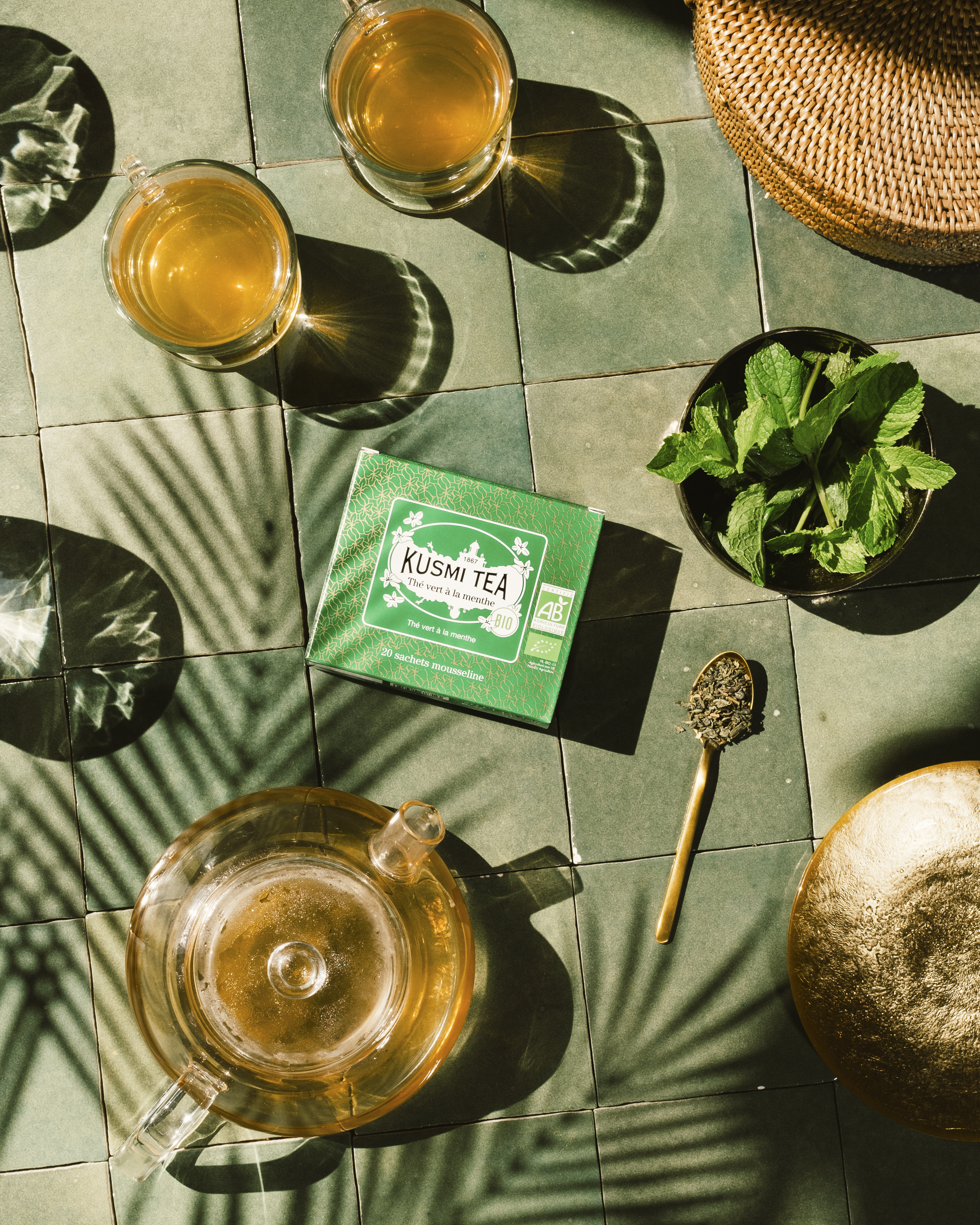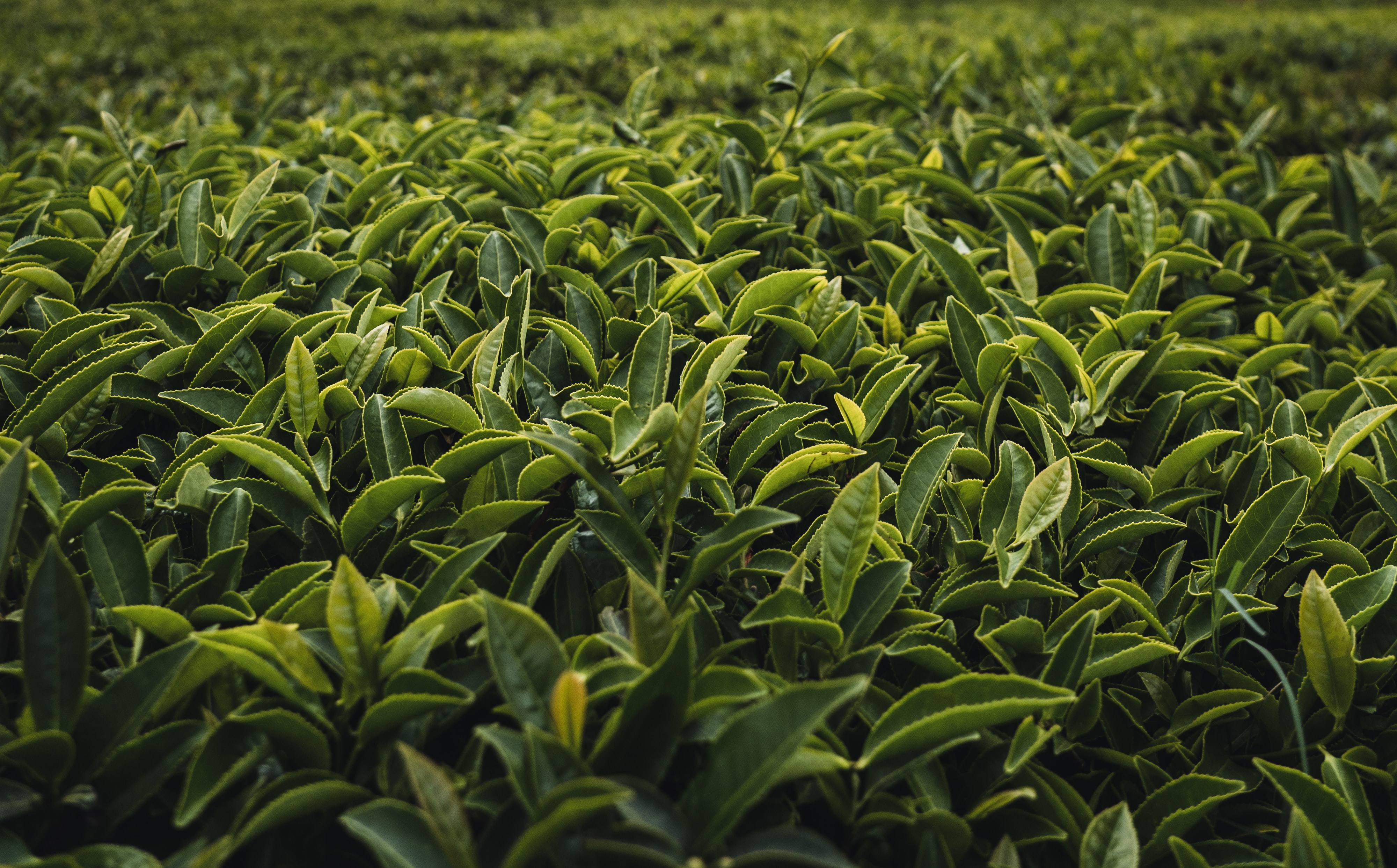Chinese green tea is native to the Middle Kingdom, and is one of the world's most consumed teas. It is produced in quantity in the birthplace of tea, and its taste and benefits have led to it being adopted in many other parts of the world. Let us introduce you.
Everything you need to know about Chinese green tea
Consumed since the third millennium BC, first as a medicinal plant and then as an everyday drink, green tea owes its name to the colour of the tea leaves. As well as the colour of its infusion.
How is it made?
No matter where on the planet it is produced, the natural oxidation of green tea is stopped rapidly after picking. The leaves undergo final drying to prevent them from darkening. After having been withered, then rolled to extract the juices, the leaves are placed in large copper basins over a fire for a few minutes. Once their enzymes have been destroyed by heat, oxidation of the plants is stopped. The tea leaves then go through the sieving stage to remove stems and dust. And then they are finally put in tea tins or bags.
How is it different to Japanese green tea?
Tea leaves are dried using a different traditional method in the land of the Rising Sun, in that they are subjected to brief jets of steam.It is “moist heat” (not “dry heat”, as in China) that helps stop the oxidation of Japanese green teas, such as genmaicha or hojicha.
The great popularity of Chinese green tea
Much consumed in its country of origin, Chinese green tea is gaining popularity in the West. Until now, it has traditionally been a black tea drinker. For example English teas, often produced in former colonies such as India or Sri Lanka (Earl Grey, Ceylon, Darjeeling, etc...). But it is Morocco where Chinese green tea has enjoyed unprecedented success, where the Chinese variety "Gunpowder" is used in the preparation of the traditional green mint tea. Gunpowder owes its name to the tea leaves, which are rolled into small balls, and which the Chinese more delicately call “tea pearls”.

What does Chinese green tea taste like?
Green teas are recognisable by their vegetable taste which is sometimes herbaceous or iodised. Steeped too long, organic Chinese green tea will tend to be quite bitter, hence the need to heed the ideal infusion time. Some will perceive a taste of chlorophyll, mineral or earthy flavours, while others will be disturbed (or enraptured!) by its astringency (that harsh, raspy sensation on the tongue, due to the tannins). As with a wine, the nuances will vary depending on the variety, the infusion time, the storage time... And of course, not all palates appreciate the same things!
What are the benefits of Chinese green tea?
Traditional Chinese medicine has long recognised the virtues of organic Chinese green tea. Above all, because it is the tea containing most antioxidants. As its oxidation has been stopped, green tea has a high polyphenols content (also called catechins). These powerful antioxidants are said to help strengthen the immune system, fight against aging, and to have a "fat-burning" effect on the body. In addition, the presence of theanine is considered to help reduce stress and provide a relaxing effect. So are the potential virtues of Chinese green tea of interest to you?
How is Chinese green tea prepared?
While the Chinese tea ceremony (Gong Fu Cha) involves three successive infusions, and can last up to two hours, here are a few preparation tips more suited to our everyday life.
What is the steeping time for Chinese green tea?
First of all, note that the water should never be boiling, but simmering, otherwise the tea leaves can be damaged. Then, the principle is simple: the more the tea is oxidised, the hotter the water can be. For green tea, we recommend water at 70-80°. Then, an infusion of the tea leaves for 3 to 4 minutes on average. As it also depends on the varieties of tea, follow the recommendations indicated on the box as this will give more details.
Which teapot should be used?
Basically, the one you already have. If you drink several types of teas (green tea, white tea, classic black tea, etc.), you will need to opt for a “memoryless” teapot, which is the case for the vast majority of them (glass, cast iron, ceramic teapots, etc.). Only unglazed terracotta teapots have a “memory”. That is, they retain the aromas from one infusion to the next. You should therefore only choose this second option if you always drink the same type of tea. If you would like to find out more, read our teapot guide.

When should Chinese green tea be drunk?
Organic Chinese green tea can be enjoyed throughout the day. From morning to night; green tea will not interfere with your sleep. It contains much less theine than black tea, which is better in the morning for its stimulating effect. (To be differentiated from coffee, which is an exciting effect). Once brewed, green tea can be drunk hot or cold, depending on the season or the mood.
The Chinese green teas selected by Kusmi Tea
Are you keen to discover or rediscover organic Chinese green tea? Let us introduce you to the different blends offered by Kusmi Tea. All you have to do is find the right one for you!
An organically farmed Chinese green tea
Since 2020, Kusmi has chosen organic for all of its teas and herbal teas. And organic Chinese green tea is no exception. All our ingredients – tea, herbs, spices – are organically grown, certified by strict specifications and checked regularly. Moreover, Kusmi is certified by Ecocert, an independent body that performs an annual audit of our workshop facilities. In order to provide consumers with the best possible information, all our tea boxes display the AB logos for France and Eurofeuille for the European Union. If you are looking for organic Chinese green tea, come to Kusmi

A green tea from China packaged in France
Like its entire range, the Kusmi Tea organic Chinese green teas are based on French know-how. Our brand (which became French in 2003) designs, creates, blends, flavours and packages its tea in Normandy. In Saint-Vigor d’Ymonville, Seine-Maritime near Le Havre to be exact. Less movement mean less pollution and more work in our region. If you want to support the French economy, you've come to the right place!
Chinese green tea packaged with the planet in mind
For both organic loose-leaf tea and organic tea in bags, Kusmi Tea is committed to recycling and reducing waste. Our made-in-France tea bags are made with polylactic acid (PLA), a bio-sourced and biodegradable material, and they are packaged in recyclable cardboard boxes. Our organic loose-leaf tea comes in metal tins, a material that is infinitely recyclable.
“LongJing” or “Dragon Well” green tea
This exceptional green tea is native to the Zhejiang province of China. In a few sips, we are transported to the heart of Zhejiang Province in southern China. Mountains as far as the eye can see and the sacred kingdom of one of the most prestigious teas in the country, namely organic Longjing, also called "Dragon Well". Harvested in spring, near the city of Hangzhou, this organic plain tea is distinguished by its long, flat leaves of a pretty shade of emerald green. Its light hazelnut and chestnut notes make its taste very popular with tea lovers. Go for it, give it a try!

The legendary story of “Longjing” or “Dragon Well” tea
Chinese mythology is full of mysteries. It is said that in the village where Longjing tea originated, there was a well that still supplied water even in times of drought. Its secret? The dragon that lived there… In Chinese mythology, the dragon is a powerful symbol! Very different from the Western dragon, it lives in water and represents strength, happiness and benevolence. Another legend reports that Emperor Qianlong stopped at a Longjing tea plantation to help the pickers harvest tea. At the same time, he learned that his mother was ill. He hurried away, accidentally taking some tea leaves in his pocket. Enchanted by the scent of the tea leaves, the Empress asked for a taste. After a few days, her health improved. So much so that the Longjing tea plants were then renamed “imperial trees”!
“Jade Pearls with Jasmine” green tea
A certain know-how has been passed on for over a hundred years in south-eastern China, that of the meticulous rolling of Chinese green tea into delicate little pearls, ready to be infused. The silver buds of this organic tea are scented with freshly picked jasmine petals. They are then rolled push by push, bead by bead. A real piece of artistry! Jade Pearls with Jasmine are a symbol of refinement and come with a little surprise. They don't infuse once, or twice... but up to 5 or 6 times consecutively, for a total duration of 20 minutes. Each new infusion brings a new revelation and an increasingly intense note of jasmine. A bit of friendly advice? Use a pot large enough to allow the leaves to unfold ... before you savour it.
Gunpowder green tea
Also native to the Chinese province of Zhejiang, located in the east of the country, south of Shanghai, Gunpowder is traditionally used to prepare mint tea. Its leaves are dried after harvest to avoid fermentation and then rolled into balls - hence the name "Gunpowder".







